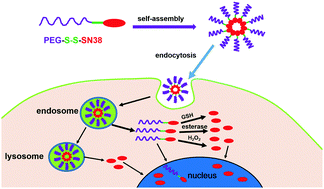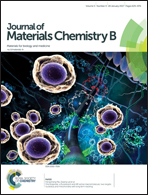A multi-stimuli responsive nanoparticulate SN38 prodrug for cancer chemotherapy†
Abstract
Modification of drug delivery systems (DDSs) with stimuli-responsive elements could significantly increase the tumor-specific delivery of anticancer drugs. Herein we synthesized a novel multiple stimuli-responsive SN38 prodrug, named PEG-S-S-SN38, by conjugating PEG (MW: 2000) and SN38 with disulfide bonds and carbonic ester linkages as linkers for efficient delivery of SN38. The amphiphilic PEG-S-S-SN38, with a high SN38 loading content, could self-assemble into nanoparticles (NPs) with a stable diameter of ∼73 nm. PEG-S-S-SN38 NPs release SN38 very slowly at physiological pH, while they quickly release SN38 in the presence of GSH, esterase and H2O2, all of which are abundant in the cytoplasm of cancer cells. PEG-S-S-SN38 NPs could be quickly internalized into tumor cells, achieve vesicular escape and nuclear localization, and exhibit remarkable in vitro anticancer activity similar to SN38. Encouragingly, PEG-S-S-SN38 NPs exhibit the same effects on cell cycle regulations as SN38 in vitro. Most importantly, the inhibition rate of tumor growth induced by PEG-S-S-SN38 NPs in a xenograft tumor model reached 72.49% ± 6.26%, which was nearly double that of the corresponding clinical drug CPT-11 (38.64% ± 13.04%) at a dosage equivalent to 10 mg kg−1 SN38. Our data suggest that the multi-stimuli responsiveness of PEG-S-S-SN38 NPs remarkably enhances their therapeutic activity against heterogeneous or mixed cell population in tumors, making this new DDS a promising alternative to CPT-11 for cancer treatment.


 Please wait while we load your content...
Please wait while we load your content...